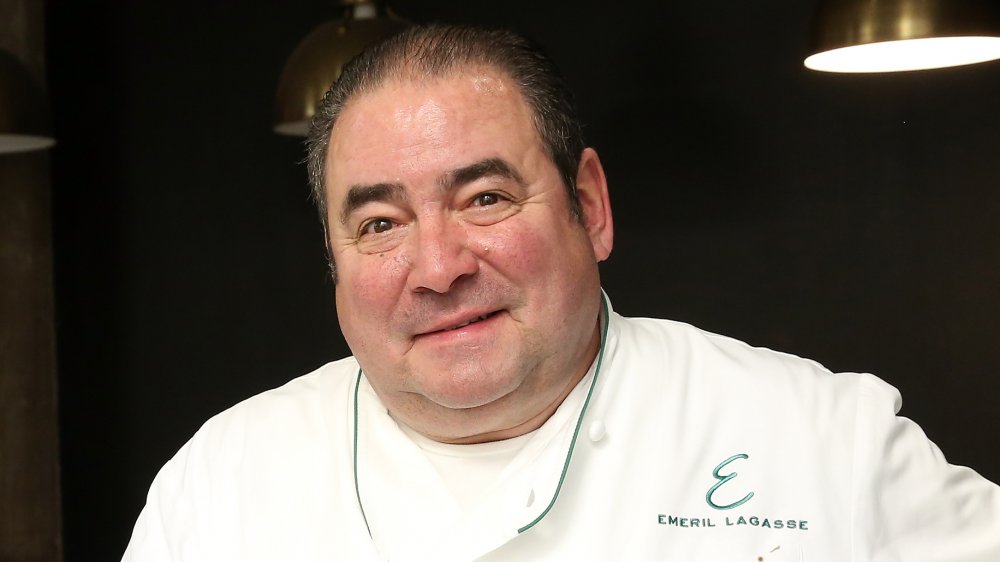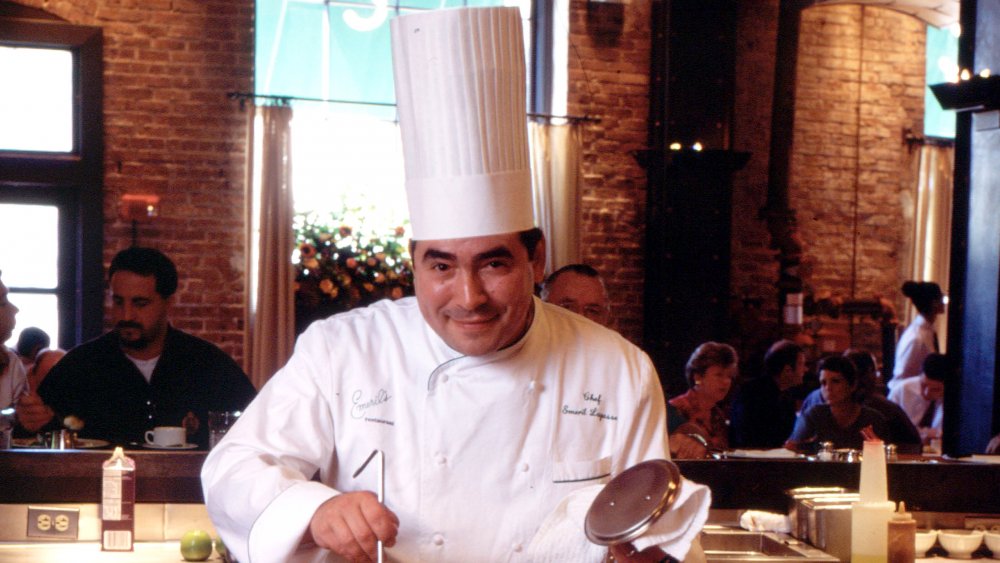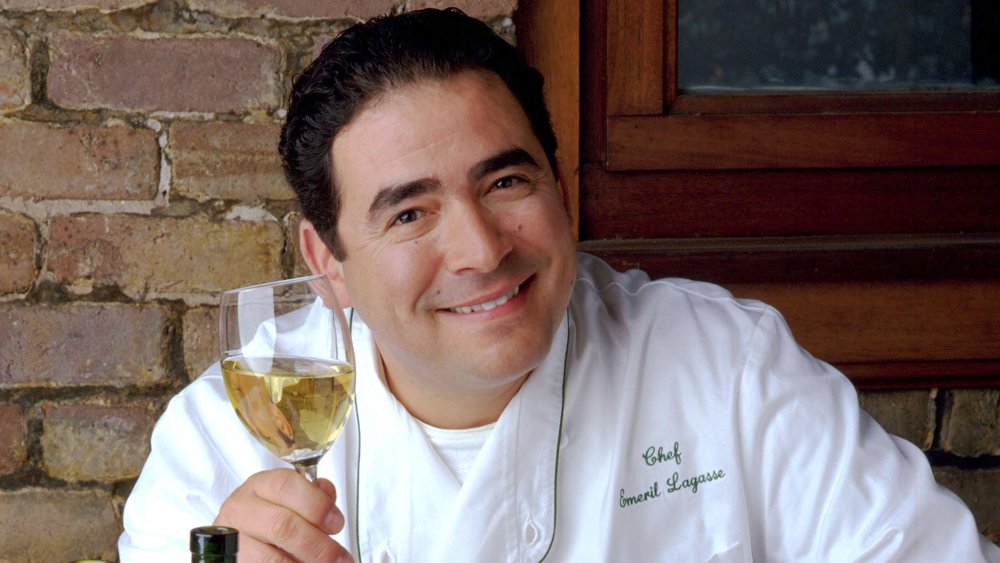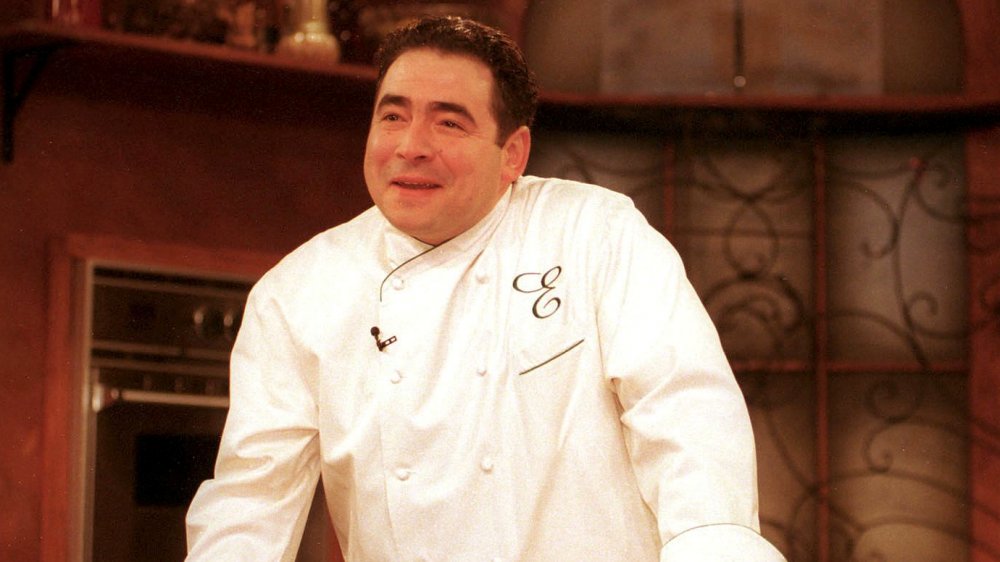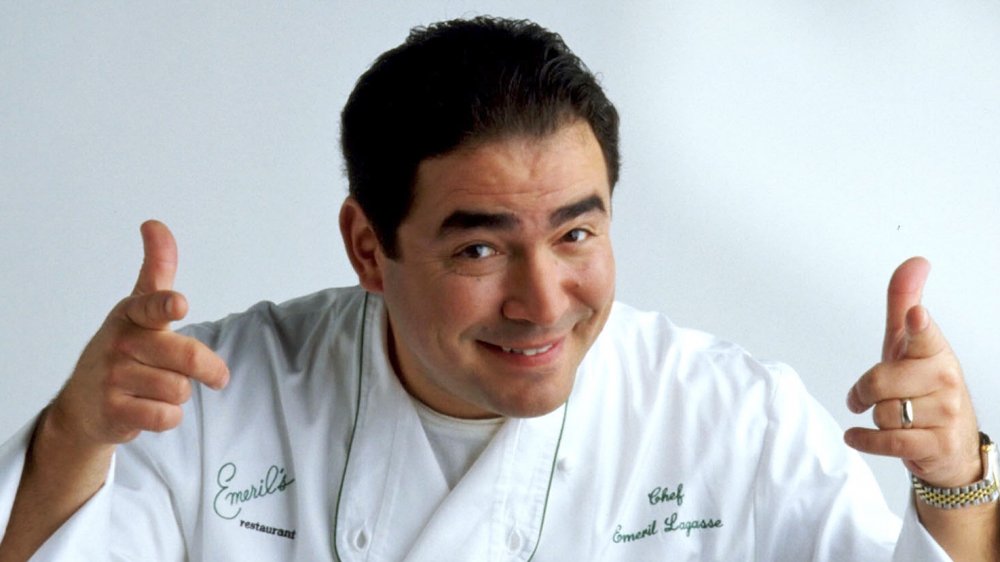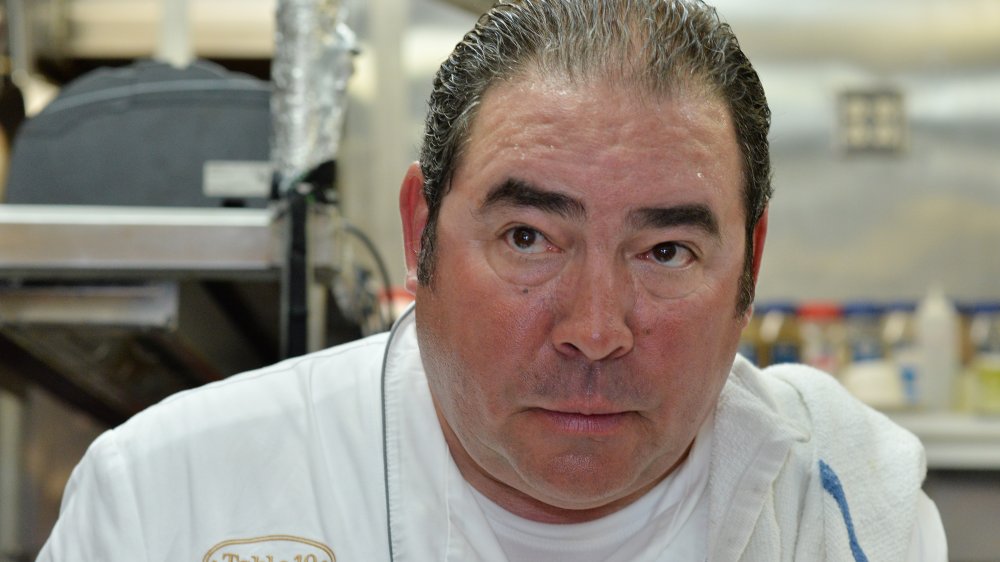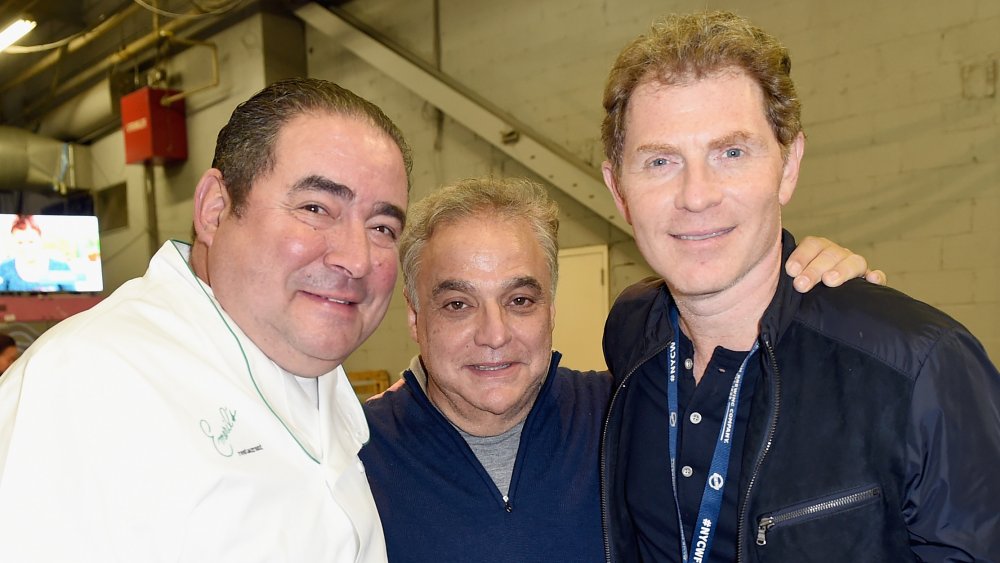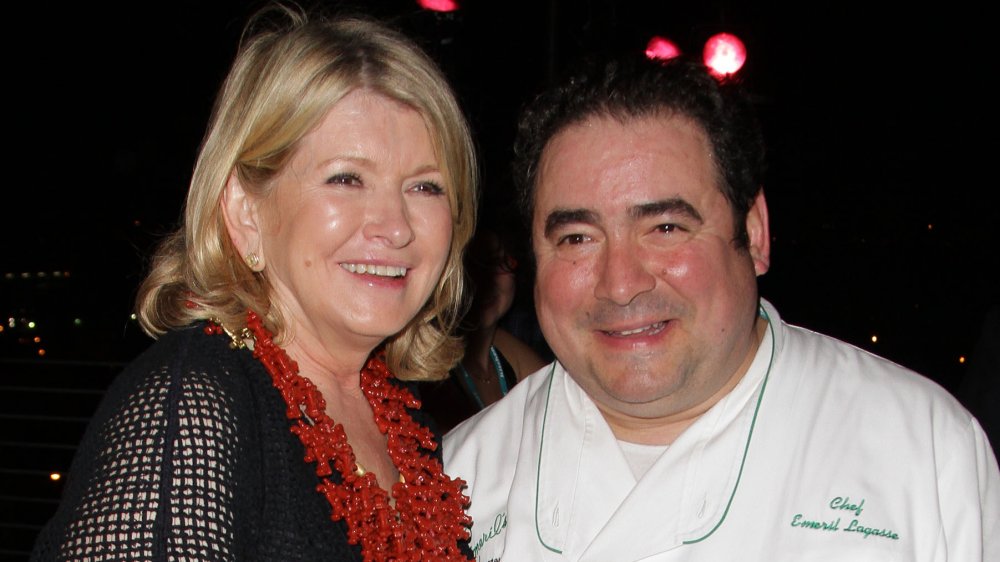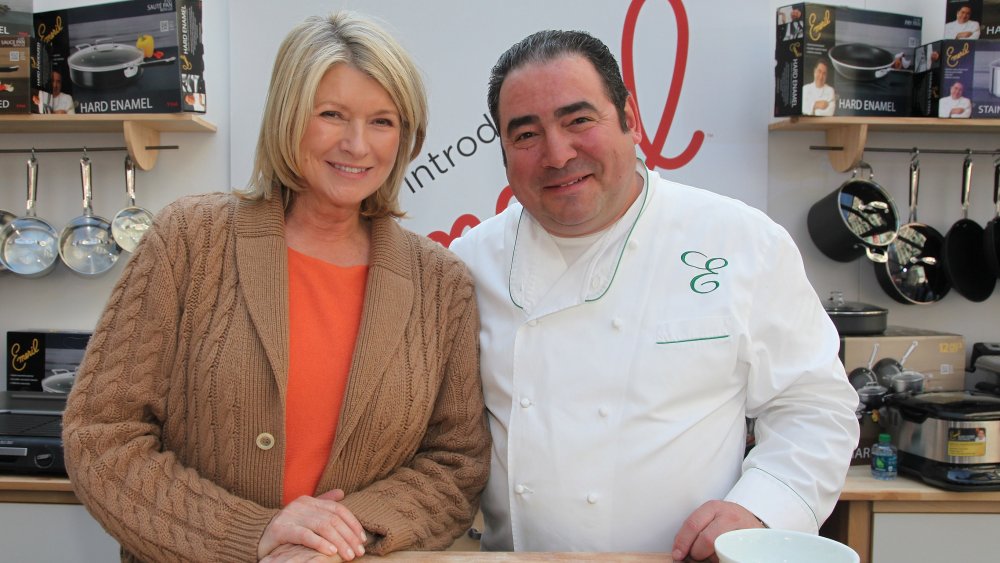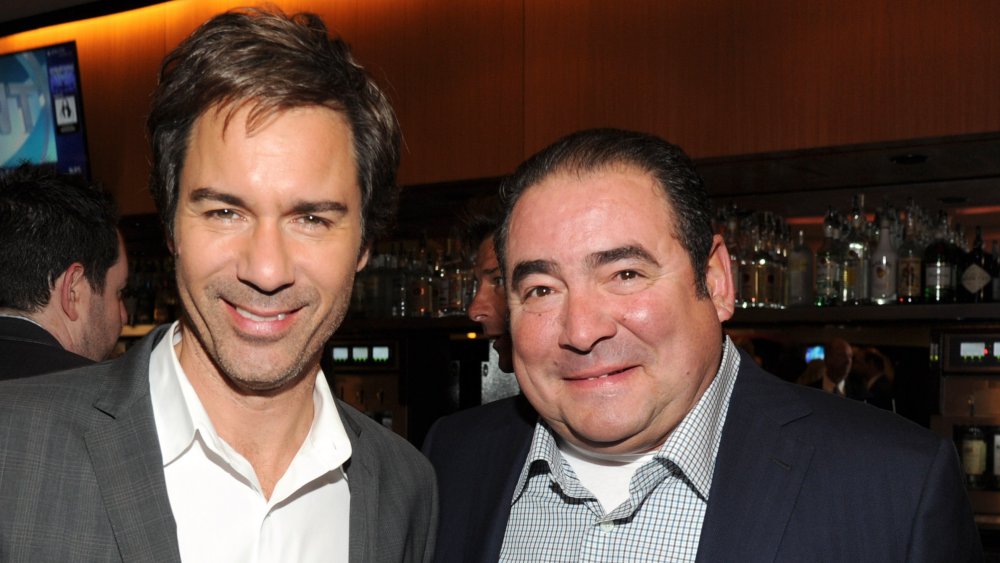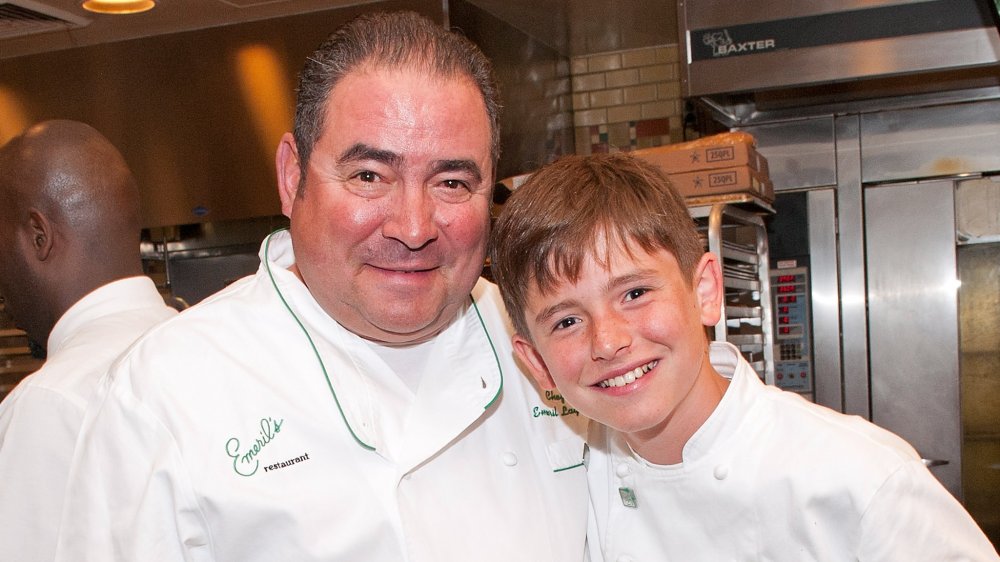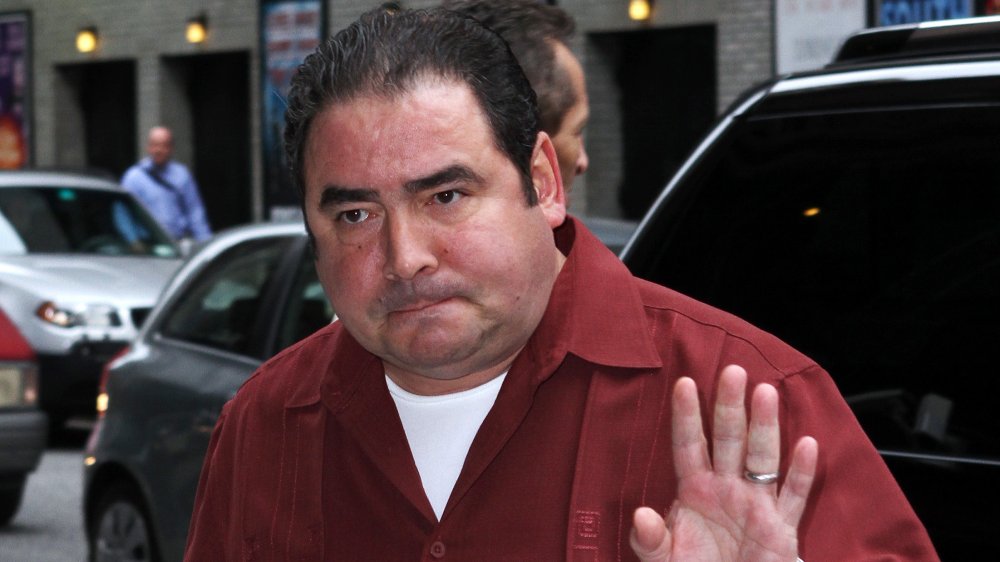The Untold Truth Of Emeril Lagasse
Emeril Lagasse is as famous for his bold Cajun cuisine as he is for shouting "Bam!" He was a pioneer of Food Network, and his two shows, The Essence of Emeril and Emeril Live, brought the start-up cable station fame and fortune. But Lagasse wasn't just a celebrity chef. During the 15 years we watched him "kick it up a notch" by tossing "gah-lic" into flaming saute pans, he was also building an empire of 13 award-winning restaurants and writing 19 best-selling cookbooks. Lagasse's charity work hasn't gone unnoticed either; in 2013, the James Beard Foundation awarded him Humanitarian of the Year.
Since Food Network gave him the boot in 2007, Lagasse has been in about a dozen shows as either star or guest. Not all were successes, and one — Emeril's Florida — is currently under investigation by the Florida House of Representatives. Lagasse has given dozens of interviews over the years, and he wants to be remembered foremost as a restaurateur. There's a lot more to Lagasse than "bam!" Keep reading, and you'll find out what you didn't know about Emeril Lagasse.
Emeril Lagasse isn't from New Orleans
Emeril Lagasse is so closely associated with Cajun cooking that you probably think he was raised in New Orleans. He was actually born and raised in Fall River, Massachusetts, a small town on the Rhode Island border, known for the Lizzie Borden ax murders, 19th-century textile mills, and vibrant Portuguese culture. His father John was French-Canadian and worked in one of the mills, while his mother Hilda was Portuguese and, as Lagasse once said, "she ruled the house."
Fans of Lagasse's television shows will remember he frequently gave Hilda credit for inspiring him to become a chef. In a CNN profile, Hilda recalled that Lagasse stayed by her side in the kitchen, and when he was 5, he begged her to teach him how to make the family's favorite vegetable soup. He was too short to reach the counter, so Hilda hoisted him up onto a stool, and "he'd do everything I told him to." The vivacious Hilda passed away in 2016 at the age of 85, but her gift for creating delicious food with a Portuguese flair lives on through her son.
Emeril Lagasse almost didn't become a chef
As reported by CNN, when Emeril Lagasse was 10, Carreiro's Bakery hired him for $1 an hour to wash pans. Two years later, the bakers taught him how to bake bread, and at Carreiro's, his passion for cooking was kindled. But Lagasse wasn't sure if he wanted to become a chef because he also loved music just as much. He was a percussion major and played drums with a local band, and performed several nights a week throughout the school year and summer vacation.
As his high-school graduation neared, the prestigious New England Conservatory of Music offered Lagasse a full scholarship. But cooking inevitably won out over music, and to Hilda's dismay, he turned it down. "My mom was absolutely crushed," he said. But his father encouraged him to go do what he obviously loves. "If you think this is a way you can get a ticket out of here, then you go for it." Lagasse enrolled in the culinary program at Johnson and Wales University in Providence, Rhode Island, and paid his tuition by working at a local Italian restaurant, the Venus De Milo, where he met his first wife, Elizabeth Kief. He graduated in 1978 and set out to France to hone his skills.
Emeril Lagasse almost didn't get his first big break
Emeril Lagasse soon found out that Parisian chefs were less than welcoming to a culinary-school graduate. He returned to the U.S. and found work as a sous-chef in Philadelphia and in Boston at the famous Parker House.
In 1982, Chef Paul Prudhomme left Commander's Palace, a legendary New Orleans restaurant. A recruiter sent Lagasse's resume to the restaurant's owner, Ella Brennan, but she rejected it because he lacked experience and was only 23. The recruiter persisted, and when Chef Larry Forgione of An American Place restaurant recommended Lagasse, Brennan relented and agreed to interview him. "Okay, I'll bring him in," she recounted to Bon Appetit. "But I'm telling you right now, I don't think it's going to work."
When they met, Lagasse charmed Brennan by telling her that the Commander's Palace kitchen "...kind of smells like my Mom's kitchen." He cooked a meal for Brennan and her brother/restaurant partner Dick Brennan, and they knew they had found someone special. A few days later, the Brennans offered him the job. "Once Emeril got down here, we really had a chemistry," Brennan told CNN. The Brennans tutored Lagasse in Creole cuisine, and he began to experiment with the restaurant's dishes by adding the Portuguese influences he'd learned from Hilda. "...When those dishes worked," Brennan said, "wow!"
Lagasse later recalled that "Ella and Dick were very tough." But they pushed him to cook better and work harder.
How Emeril Lagasse built his empire
After over seven at Commander's Palace, Emeril Lagasse wanted to open his own restaurant. He found an abandoned space in New Orleans' Warehouse District, which, in 1990, was rundown. "Just a really scary time," Lagasse recalled. During the building's renovation, Lagasse locked himself in an office for 15 hours a day writing and testing recipes. "Today those dishes kind of seem...ugh, okay," Lagasse said in an Eater interview. "But if you think [back to] 25 years ago, those dishes were so cutting-edge for New Orleans."
Emeril's opened to rave reviews and was selected by Esquire as "Restaurant of the Year." The following year, Wine Spectator gave Emeril's the "Grand Award," and the James Beard Foundation dubbed Lagasse the "Best Chef South." Two years later, Lagasse opened NOLA, again to glowing reviews. By 1993, executives at the new cable station, Food Network, had heard of Lagasse and offered him a show, How to Boil Water.
By Lagasse's account, the show was terrible, but Food Network recognized a potential superstar and gave him a new show, The Essence of Emeril. Lagasse was able to loosen up and be more of himself. As TV Guide critic Matt Roush said "He's just a normal guy who cooks great Cajun food and really gets off on it." In 1997, Lagasse's skill and colorful personality were showcased on Emeril Live, which combined Lagasse's two loves, cooking and — with a live band on the set — music.
During the show's 10-year run, Lagasse's energy never flagged: He opened four restaurants and wrote 10 cookbooks. In 2000, he signed a deal with B&G Foods to distribute Emeril's Original — a signature line of seasonings, salad dressings, marinades, and pepper sauces — which he promoted on Emeril Live. By 2005, Lagasse valued his empire at $150 million worth of business each year.
How Bam! became Emeril Lagasse's catchphrase
During the production of The Essence of Emeril, Emeril Lagasse shuttled back and forth between his restaurants. To accommodate his schedule, the show had to shoot eight shows a day, Sunday through Tuesday. Three or four shows were shot in the morning, and then the six-person crew took their lunch break, devouring the rich meals that Lagasse had just prepared on the set. When shooting resumed, he noticed that "everyone here is practically sleeping because they ate so much." So when he saw them nodding off, he'd shout Bam! "...to wake them son-of-a-guns up." Thereafter, "bam!" became a regular catchphrase. He tried replacing "bam!" with "pow!" but the changes didn't stick. "Bam is just kinda me," he told Bon Appetit.
Lagasse had two other catchphrases that he used in his restaurants and television shows — "kick it up a notch!" and "it ain't rocket science!" — that were also popular with fans. But even today people often yell "Bam!" at Lagasse when he's out in public.
Emeril Lagasse felt betrayed by Food Network
In 2004, outside consultants reported to new Food Network president Brooke Johnson that "dump-and-stir" cooking shows, like Emeril Live, were losing ratings to the more exciting competition shows, like Iron Chef America and Top Chef. If Food Network was going to survive, it would have to become less of the "Emeril Network," according to NPR's reporting of Allen Salkin's book From Scratch: Inside the Food Network.
Johnson still believed in her superstar chef and allocated hundreds of thousands of dollars to overhaul Emeril Live with a new set and top-of-the-line equipment. But in three years' time, the high-energy shows — like Bobby Flay's Throwdown — were killing Emeril Live in ratings. On top of this, Emeril Live was expensive to produce. Because of Emeril Lagasse's astronomical salary, one episode of Emeril Live cost as much as a full 13-episode season of a new show. In 2007, Johnson warned Lagasse that the direction of the network may be changing. "You're full of it," he halfheartedly joked. He knew his audiences were graying, but he believed the show would bounce back. "This show is the network still," he said. "You're not canceling it."
Network executives thought otherwise, and on December 11, 2007, the last Emeril Live was shot. Johnson told The New York Times that "all good things come to an end, and it was time to do something new. " A few weeks later, she informed Lagasse that Food Network was also ending production of The Essence of Emeril. Lagasse didn't understand why the network was evolving without him. He had devoted a lot of his life to Food Network, and now they were slamming the door in his face.
Emeril Lagasse could have been an Iron Chef
Marketing head Susie Fogelson wanted to keep Emeril Lagasse at Food Network. She suggested to Lagasse's agent, Jim Griffin, that Lagasse should be a competitor on Iron Chef America. But Griffin was against it. "We don't want to see Emeril in an aggressive situation like that, he told her." Instead, Lagasse wanted to invite family-friendly guests, like the Sesame Street character Elmo with whom Lagasse had appeared in the video, Elmo's Magic Cookbook.
When Emeril Live got pulled, Lagasse retreated to New Orleans and worked as a line cook at his restaurant. He was fuming and confused about why he'd been given the boot. "When it ended, everybody felt like it was time for a little break," Lagasse told GQ. "I didn't necessarily think that." Fogelson didn't want to give up on Lagasse, so she summoned him back to New York to discuss his future with Food Network. Again, she proposed that he might pivot to a competition show. "Maybe you should try doing something on Next Food Network Star, or maybe Iron Chef?"
But Lagasse wasn't having any of it. He had more experience than any of the novice cooks he saw scrabbling and backstabbing for a show at Food Network. "How about Platinum Chef?" Lagasse yelled at Fogelson."Have you thought of that?" And he stormed out.
Martha Stewart saved Emeril Lagasse's businesses
In 2005 Hurricane Katrina devastated New Orleans, and Emeril Lagasse's three restaurants — Emeril's, Delmonico, and NOLA — were severely damaged with over $2 million in losses (over $1 million in wine alone) from flooding and looting. Compounded by the destruction of his home in Mississippi and cancellation of Emeril Live, Lagasse was paddling through some rough financial waters.
But in 2008, as reported in The New York Times, Martha Stewart and her company Martha Stewart Living Omnimedia (MSLO) rode to the rescue and bought up the rights to Lagasse's culinary franchise, including his televisions shows, cookbooks, Emeril-branded spices, and cookware for $45 million in cash and $5 million in stock. In the deal, Lagasse retained ownership of Emeril's Homebase, his New-Orleans-based consortium of restaurants.
Stewart considered their tastes and style as vastly different, but as she told The New York Times "Being complementary and different is better than being competitive." In an NBC interview, Lagasse said "She showed up at a time when I thought the whole ship might be going down." After the deal was completed, Lagasse didn't seem to regret relinquishing his cookbooks and licensed products to Stewart. "My little bit just fits into a corner of her empire," he said, "and I'm happy to be there."
Emeril Lagasse and Martha Stewart were sued for selling knock-off knives
In 2012, the Chamber of Industry and Commerce Wuppertal-Solingen-Remscheid, Germany, filed a lawsuit against Emeril Lagasse, Martha Stewart Living Omnimedia, and Home Shopping Network for "willfully and maliciously engaged" in counterfeiting and selling Wüsthof knives purportedly made in Soligen, Germany, a city renowned for its steel-forging since the 11th century. The lawsuit claimed that the inferior knives were branded with Emeril's and Solingen's trademarks on one side of the blade and on the other side were marked "China," where the knives were actually made.
The Chamber owned the Solingen registered trademark, and the lawsuit further accused Lagasse, Stewart, and MSN of having "been unjustly enriched by illegally using [the] Chamber's intellectual property" for their own financial gain. Included in the complaint were several negative reviews from HSN consumers, one of whom wrote: "That is terrible when a top chef lies to you on TV... Emeril cannot be trusted with what he advertises."
The Chamber sought damages of $2 million for each time Lagasse, Stewart, and HSN infringed the Solingen trademark, totaling $24 million. The lawsuit was settled in 2014 for an undisclosed amount and, per Today, a permanent injunction was put against Lagasse, Stewart, and HSN that prohibited them from selling products with the Solingen trademark.
Sometimes, being in business with Martha is not "a good thing."
Emeril Lagasse starred in his own sitcom
In 2001, Emeril Lagasse was at the height of his TV fame, and Designing Women creator Linda Bloodworth-Thomason whipped up a frothy sitcom for him. "The plan was to put Emeril Lagasse in the middle of these loud, mouthy Designing Women-types with great food," Bloodworth-Thomason said. NBC initially had high hopes for their new sitcom star, but during production, it reportedly became apparent that the show had problems. As Bloodworth-Thomason noted in The Hollywood Reporter: "He was expected to become an actor overnight, and it just didn't work." Lagasse was so accustomed to ad-libbing on Emeril Live that he couldn't keep to the script. "You can't script Emeril," Bloodworth-Thomason said.
Emeril premiered two weeks after 9/11 — understandably a tough time in history for hooking new audiences. Reviews were uniformly dreadful. "Sitcom anorexia," the Los Angeles Times critic wrote. "Lagasse, shmasse, dump this sucker fast." The show failed to draw an audience, and although ten episodes were filmed, Emeril was canceled after its seventh episode aired.
Emeril Lagasse's charity has raised $10 million for children's causes
Lagasse married his third (and present) wife, former realtor Alden Lovelace in 2000, and two years later, they founded the Emeril Lagasse Foundation with the intent of creating opportunities for children in disadvantaged situations. Its mission statement is to help youth realize their full potential through culinary, nutrition, and arts education. The Foundation has funded programs for teaching children how to grow sustainable foods, and culinary and hospitality training in school cafeterias.
In 2005, after Katrina's devastation of New Orleans, the Emeril Lagasse Foundation created a fundraising event, the Carnivale du Vin, which featured a high-end wine auction and walk-around tastings by Lagasse's celebrity-chef friends. The inaugural event raised $1.4 million, the proceeds of which were donated to organizations helping New-Orleans area children whose families had lost their homes in the hurricane. The Carnivale du Vin has been an annual fundraiser since it began.
The Foundation continues to provide funds to communities affected by natural disasters and to date has raised more than $10 million and helped thousands of children in need. Most recently, the Emeril Lagasse Foundation committed $500,000 to non-profits supporting Covid-19 relief efforts.
Emeril Lagasse's Florida show is under investigation
Eventually Lagasse and his family left New Orleans behind and moved to Destin, Florida, a popular tourist destination along Florida's Emerald Coast on the Gulf of Mexico. In 2013, The Cooking Channel and Food Network jointly premiered Lagasse's new television series, Emeril's Florida, which spotlighted Florida's restaurants and cuisine, including his own. Visit Florida shelled out $16 million — $12.7 million of which was taxpayer money — to promote Florida tourism on the show. In 2017, after the show was canceled, the Florida House of Representatives began an investigation into the show's finances. According to Politico, the show's producer, MAT Media, reportedly received $1.25 million and Lagasse $4 million.
MAT Media's owner, Pat Roberts, refused to turn over financial records, claiming he could be sued, and the House issued a subpoena for them. Roberts filed for an injunction to protect trade secrets, which included how much Lagasse had been paid. U.S. District Judge Mark Walker dismissed the injunction because Roberts was in no imminent danger of being punished. Roberts appealed, and Circuit Court Judge Karen Grievers blocked the subpoena. Adding to the twists and turns, Judge Grievers' order was reversed on February 7, 2020, so MAT Media must now comply with the House's subpoena. At present, the investigation into Lagasse's and Roberts' payments is ongoing.
